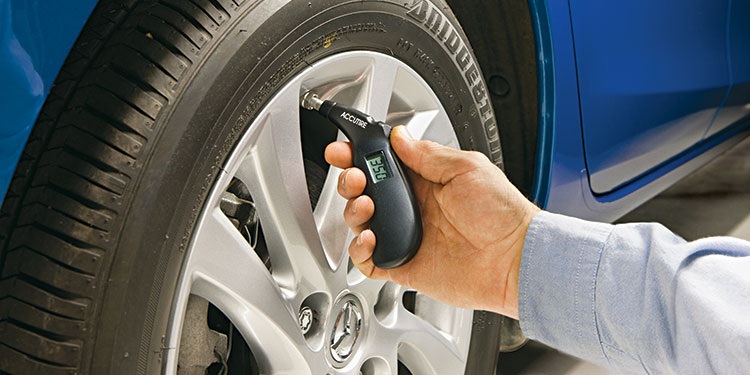We have already written how to inspect the geometry of the body , the generator , the ignition system , the battery , the engine , and the chassis when looking at a used car . In this article we will tell you how to check tires when buying a used car.
Some experts argue that the use of used tires is similar to Russian roulette – rely only on luck. And to make the event really happy, you should check the wheels as closely as possible.
How to check the tires when inspecting cars
When inspecting a vehicle and used rubber, check the following:
Year of manufacture of rubber;
Tire wear;
Tread depth;
Traces of tread repair;
The degree of wear of the coupling edges;
The presence of microcracks;
Cuts and tire repair marks.
Each of the parameters is important in its own way, and therefore ignoring at least one of them can significantly reduce the level of safety on the road.
How to find out the year of production of rubber
We recommend to check first. If the tires have served their allotted time, further operation does not seem to be rational. It’s easy to do – the date consists of two numbers: the number of the week and the year of release, is applied to the outside of the rubber. If at inspection of the car it is found that the numbers on each wheel are different, then this indicates a non-simultaneous replacement of wheels. The reason for the replacement, if the service life has not yet come, you should ask the seller.
Tire wear
To check tire wear, visual inspection is sufficient. It is important that tire wear (if any) be uniform over the entire wheel circumference. Violation of the uniform wear of tires can be a sign of imbalance of the wheels, and this also indicates a possible inaccurate driving style of the previous owner, which may cause several more problems during the operation of the car. Increased wear from the outside indicates insufficient tire pressure, which should also be checked before a test drive. The operation of such wheels is fraught with the fact that cornering tires will be bad “hold” the road. If the central part was more subject to wear, get ready to reduce the acceleration speed, handling and braking.
Measure Tread Depth
When buying a car, be sure to pay attention to this parameter. Tests show that the permissible tread depth should be at least half of the original – for summer tires is at least 3 mm (1.6 mm by law, but it is better to leave a margin), for winter tires – at least 4 mm. Check the depth is easy – in the automobile, you can buy a special probe with labels or use a simple ruler.
Traces of repair
When inspecting the tread, it will not be superfluous to check for signs of repair from the inside (on a smooth surface). By themselves, patches on the tread are not critical, but only if their number does not exceed a pair of pieces per wheel, and their size is one third of the width of the pattern. Otherwise, the operation of the “horse” on such wheels should be abandoned. Pay attention to the nature of the patch – the restored tread pattern (the so-called “cutting”) can turn into a tire break.
The degree of wear of the coupling edges
The adhesion of the tire with the road surface occurs over the entire width of the tread. The edge of the tire also affects the braking performance. The smaller they become, the less adhesion of rubber to the road surface, and, consequently, increases the risk of movement on a wet or slippery surface. Worn front edge indicates problems with the suspension of the car, which is also worth paying attention to. You can check this part of the tread “by touch” – the problem is present if the teeth on the tread edges differ in sharpness.
The presence of microcracks
Tire cracks may appear even in conditions of minimal rubber wear and lean storage. The average service life of rubber is 5 years, but, as a rule, by the end of the term, the tire naturally becomes unsuitable. In the presence of small cracks, it is not recommended to exceed the speed of more than 80 kilometers per hour, otherwise the chances of complete tire wear are rapidly increasing. Deep cracks appear with a large degree of splitting of the tire. To use this rubber is not recommended.
Tire repair tracks
Defects in the form of cuts and signs of repair are a clear signal to keep away from the selected used tires. As a rule, side cuts of the tire are dangerous due to the fact that the repair of such defects is extremely difficult and does not provide any further guarantee of the quality of rubber operation. But, in addition, it is necessary to check and ensure that there are no implicit damages. The deformation of the carcass tires in the form of dents and creases can be the result of driving or parking on a flat tire, as well as a strong blow. The end of life in this case may occur earlier than expected.
Internal stratification of a tire is extremely difficult to detect. A warning can be a different kind of bulge on the inside of the tire. Visible layer breaks are also possible. Check the degree of tire pushing – from pressing with two thumbs, the tire should not deform much, but will quickly return to its original shape.
These tire and wheel test options apply to both summer and winter tires. But, in the cold season, when the car “pereobut” in winter tires, you should consider some other factors.
Buying a car on winter tires, checking the tread
In winter, buying a car on winter tires is considered correct, but another situation is possible, so do not neglect the inspection of the wheels. First of all, you should check that the car is “shod” – it can be idle for a long time, especially if the transaction occurs on the car market. Winter wheels are divided into two types: studded and friction.
Stud tires are distinguished by the presence of spikes. The presence of all or the vast majority of spikes is considered ideal and ensures good adhesion to the road, and, as a result, road safety.
Friction tire is available without studs. Its difference from studded – a special composition of rubber, which has adhesion with the road surface like velcro. This type is more suitable for urban environments.
Equally important is the tread depth. For 100%, it is customary to take the tread depth of a new tire, 0% – unsuitable to use, respectively. The minimum allowed tread depth of winter tires reaches 4 mm, otherwise – 0%. From the factory tires are produced with different depths. Keep in mind that if the initial depth reached 8 mm, then 4 mm is not 50% of wear, as some sellers claim.






